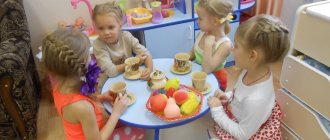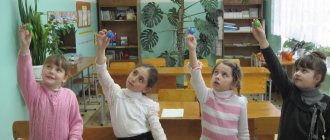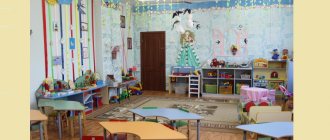Musical development is very important for any child. And this does not mean at all that it is necessary to raise a brilliant musician from a baby from the cradle, but it is within our power to teach him to listen, understand music, and enjoy it. When should musical development begin and what should it consist of?
Musical development contributes to the holistic formation of a child’s personality. While listening to music, the central nervous system and muscular system develop, the process of socialization is facilitated, artistic thinking and a sense of beauty develop.
Musical development from birth to 2 years
As you know, auditory perception (not an example of visual perception) is very well formed by the time the baby is born. While still in the mother's tummy, the baby hears her voice.
The child repeats human speech and animal sounds. Inanimate nature (the knock of a door, for example) does not interest him at all. Researchers have noted that the babble of all children in the world is the same, regardless of what language is spoken around them.
Turning to rattles, it is worth noting that they produce a wide variety of sounds - dull, crackling, like maracas, or ringing, like a bell. When purchasing, try to select as wide a range of sounds as possible. Invite your baby to compare the sounds of different rattles.
Currently, electronic musical toys (mobiles, musical mats, electronic pianos, etc.) occupy a large niche in the children's goods market. It is important that the music played is recognizable and of good quality. It is also valuable that in order to extract a sound (melody), the baby will need to perform an action - hit a key, turn a lever, touch a toy, etc. This will contribute to the formation of cause-and-effect relationships at the “reaction-stimulus” level, thereby developing cerebral cortex.
For a very young child, you intuitively offer calm lullabies before bedtime, and playful and rhythmic songs while awake. A two-year-old child can be asked to choose for himself which option from the proposed musical excerpts is most suitable, for example, for charging. Explain what the expression “to do to music” means. Children will understand its meaning perfectly if they do not hesitate to exaggerately seriously depict marching movements to Grieg’s music. It turns out? No. Movements to this music should be smooth and measured.
Of course, you can use recordings of songs from cartoons. But don’t be lazy to add variety. Children respond very well to “soft” jazz compositions (with an easily discernible main theme). It is good to offer them before going to bed. For example, works such as “Summertime” by J. Gershwin, “Hosanna,” and almost any work by Weber are suitable. From the repertoire of classical music, you can stop at Beethoven’s “Fur Elise” and the 14th Sonata (Moonlight), Griboedov’s waltzes, Glinka’s nocturnes, Grieg’s “Peer Gynt”, Massenet’s “Elegy”. For an active pastime, take the Italian polka and Rachmaninoff’s 14th concerto, Mozart’s Turkish rondo, Khachaturian’s waltz to the drama “Masquerade”, “The Joke” from Bach’s orchestral suite.
Nowadays there are a great variety of thematic CDs with recordings of musical works arranged for children. These are variants of popular works without chords and second themes that are difficult for a child’s ear. Almost the same melody sounds.
At any age, it is pleasant and useful for a person to listen to recordings of the sounds of nature - a babbling stream, a raging sea, rustling rain... But do not forget the immutable rule - talk to your child about what he heard. Ask your child if he liked it, what he thought about while listening, what feelings he experienced. After all, it may turn out that he has unpleasant associations. Discuss everything you heard for the first time, paying attention to the emotional side (what feelings, images arise).
How to listen to music?
An indispensable condition is silence in the room. Nothing should distract the baby. The mother is sitting next to the child, or the baby is in her arms, or both are sitting on the sofa. Mom listens too. Her face is interested, attentive, friendly. Mom likes music - the child sees this. Her mood and condition are transmitted to the baby. If the mother plays the piano herself, then the grandmother or father sits with the baby.
We recommend listening to music once or twice a day. This could be one piece repeated twice, or two pieces. For example, “Bunny” and “Bear”. By the end of the third year, you can audition three plays.
Have you already noticed that you were offered to play different musical instruments even for a six-month-old baby? But what if you don't have these skills?
2-3 years - first instruments
We have already become proficient in listening to music, and the good old, but already boring rattles are being replaced by real musical instruments. In this age range, it would be most optimal to pay attention to familiarization
baby
with musical instruments
.
Drum
, you can be sure it will be received with a bang. Invite the young drummer to slap the drum with his palm, then tap with his finger; the surface can be stroked. Beat the drums; Although the baby is not yet able to do such exercises, by doing this you will expand the range of sounds produced for him and stimulate interest in further manipulations. The chopsticks should be put aside for now to avoid injury.
Then we offer a tambourine
- in fact, a complicated version of the drum - you can beat and ring.
Show your baby how to accompany any melodies. There are many accompaniment options. The simplest one is hitting the downbeat—places that sound stronger and clearer. For example, “There was a grasshopper sitting in
the
grass
,
just like a
little
cucumber
,
”
and
the trembling of bells for drawn-out vowels. “The Waterman’s Song” is perfect, in particular the phrase “I’m dying to fly” or “Winged swing”, that is, slow melodies.
These musical instruments are the best way to show what tempo and rhythm are. Kids perceive the association with steps well. Top... Top... Top... (pause for 2-3 seconds). Top. Top. Top (at normal pace, without pauses). Top-top-top they ran (quickly). Now also with your fingers on the drum/tambourine. Check if your baby understands you by listening to children's songs. They tend to exhibit a distinctly fast or slow tempo. In the first case, “Or maybe a crow”, “Little Red Riding Hood’s Song”, “Dance of the Little Ducklings” are suitable. The slow pace is perfectly illustrated by “The Waterman’s Song,” “The Turtle and the Lion Cub’s Song,” and “The Bear’s Lullaby.”
It is important that listening to children's songs initiates the baby's singing activity, promotes speech development, and enriches the passive vocabulary. Attempts to sing along will contribute to the development of the articulatory apparatus, and correlating the musical theme with your favorite cartoon will create a positive mood and improve your emotional state. Children usually do not hesitate to sing out loud, unless “kind” adults once said something unflattering about such singing. Do not allow this to happen, otherwise you will have to correct the mistakes you have made - fearlessly demonstrate your love of singing by personal example.
The next step is to show different sound durations and rhythms. So, with your left hand, beat the drum slowly and rhythmically (every two seconds), then add your right hand (every second). We get one blow with the left and two blows with the right. Now invite your baby to “replace” your left hand - first let him put his palm on top and feel the rhythm, then quietly remove your palm. And before us is a tandem of drummers! Then you change “scores”, speed up or slow down the tempo, change the beat ratio (1:4), etc.
And now - spoons
. You don't even need to buy them. There are probably a couple of wooden spoons around the house. Fold them with the back sides, fasten the ends for convenience with an elastic band. It is quite enough for initial acquaintance. You need to hold the spoons by their fastened tips, without squeezing them too tightly, otherwise, when squeezed, they will not make a knock. It is not so easy for children to grasp spoons correctly; it is much more common to grasp them more tightly, like a rattle. You will need to achieve some relaxation. The sound of spoons is traditionally combined with folk songs and chants, but almost any ri, “Antoshka”, “If only there were no winter”) will do. If you suddenly find a ratchet on sale, you can also offer it to your child. Just like spoons, this instrument requires some coordination of movements to produce sound. This requires coordinated work of the muscles of the hand and forearm. Playing the rattle is convenient to accompany chants and ditties (you can use “Ditties of grandmothers of hedgehogs”).
After 3 years, you can offer your child a metallophone. Melodic scales can inspire children's creativity - something their little ears have never heard before. In this case, it is necessary to take into account that the stick should be held lightly, without squeezing, otherwise the sound will not be clear. Kids don’t “catch” this moment right away, but over time everything will start to work out.
In the second and third year of life
Children of the second year of life can actively listen to continuously playing music for 40 seconds, then a break (1-2 seconds) and again for 40 seconds, a pause, etc. In general, one lesson lasts 2-3 minutes.
Children of the third year of life can perceive continuously playing music for 1-1.5 minutes, then a pause and another minute and a half, etc. One lesson - 4-5 minutes.
The numbers - seconds and minutes - are given here so that you do not overestimate the capabilities of a small child and at the same time know that listening to music is quite within the baby’s capabilities. It all depends on his condition at the moment you chose to listen to music: a child listens to music worse if he has just cried - for example, his beloved grandmother has left, or he has just finished feeding him unloved porridge, or maybe he is simply unwell.
When you see that your child is distracted or expresses displeasure, reduce the time of the lesson or move it to another time of the day. If the child’s attention is stable and he is able to perceive music with interest, you can slightly increase the duration of the lesson.
Music for children 4 years old - listening to music
The four-year-old listener is already quite experienced, still inquisitive, restless and impatient. Right now you should spend most of your time listening to music.
While listening to a piece of music, your child will easily understand the tempo and identify the instruments he knows. It's time to expand his horizons and introduce him to new musical instruments. This will allow you to perform an important mental function when listening to music - analysis, which is necessary for the mental development of the baby. With new knowledge, the child is ready to attend the conservatory. You can anticipate your cultural journey by watching videos of concerts, analyze and discuss what you hear.
Music, it turns out, can tell a lot about itself. Not only about tempo, rhythm and composition of instruments. Let's get acquainted with the words "major" and "minor". The antonyms fun and sad will help make them accessible to the child’s understanding. And offer to determine which work is suitable for what. For a minor, you can take Tchaikovsky’s “The Doll’s Disease,” and for a major, Mozart’s “Turkish Rondo.” Major is always confident, joyful, flaunting, minor is sad. It is even easier for children to determine the nature of music as follows: major - you want to laugh, minor - you want to cry. The baby needs to choose what is best to do while listening to the music and “make a diagnosis.”
To consolidate this material, it is good to practice on the following pieces of music. Minor - “The First Loss” by Schumann, “Dance of the Little Swans” by Tchaikovsky, Russian folk song “A Birch Tree Stood in the Field.” Major - “Italian Polka” by Rachmaninov, “Clowns” by Kabalevsky, “Chunga-Changa”. Now there are even more strange-sounding words, but they are even easier to explain: staccato - sharp, jerky and legato - smooth, slow. When performing staccato, each sound “speaks” separately, waits its turn, and in the case of legato, the sounds “flow” into one another. For example, “There was a birch tree in the field” is an obvious legato, the song “Smile” is an undeniable staccato.
And, of course, it is worth organizing acquaintance with a wider range of musical instruments. The kid is already familiar with the drums. From the group of keyboards, it is quite possible to show the piano; mention the organ, harpsichord (the child will see them at the conservatory). The wind group will be represented by flute and trumpet. It would be good if, along with the sound, you could show an image of the instrument.
Before going to the conservatory, tell your child about the rules of behavior in this place. Explain that it is not customary to talk, get up, or make noise during a performance. For beginners, subscriptions to short-term concerts are offered. You can visit the concert hall of the Russian Academy of Music. Gnesins. It hosts Sunday afternoon concerts; Among other works, sketches by Liszt (for example, “Round Dance of the Dwarves”), Grieg’s music for Ibsen’s play “Peer Gynth,” and Saint-Saëns’ “Carnival of the Animals” are performed. It will be very nice if, during the first visit to the conservatory, the child hears already familiar works - this will make it possible to more clearly appreciate the difference between playback from a disk and “live” sound. For your first visits, you can choose a cycle of plays by Kabalevsky, works of small forms by Mozart, and folk songs. then choose the musical fairy tale “The Wolf and the Seven Little Goats”, the operas “The Tale of the Dead Princess and the Seven Knights”, “Rikki-Tikki-Tavi”, “Flint”.
No less interesting for your child will be a visit to the Russian Center for Museum Pedagogy of Children's Creativity at the State Russian Museum. You can go there with a two-year-old child, for example, for the subscription “At the Art Museum with Mom”, “Games with Sounds and Colors”. For 4-year-old children, we offer the “Meetings with the Beautiful” subscription.
At the Moscow International House of Music, children and their mothers will be offered a fabulous concert “The Little Humpbacked Horse” and “The Tale of Tsar Saltan” based on the opera of the same name by Rimsky-Korsakov. At the Moscow New Opera Theater named after. E. V. Kolobova will present the opera “Cat’s House” to the attention of young listeners.
You can also visit the children's musical theater named after. N. Sats with a rich repertoire of performances for children.
Interesting performances can be watched in the musical theater “Experiment Kommersant”. The most successful productions are “A Kitten Named Woof”, “The Flying Ship”, “The Cat Who Walked By Itself”.
At the age of 4 years, it is useful to become acquainted with such a technique as meditation to music. Quite recently, the crisis of three years has passed (or you are still in the process), the baby is aware of himself in the world around him separately from you, feels like an independent person, but this is not so simple. Try meditating with your child. An important condition is a balanced, calm emotional state of the parents. Choose calm, transparent music, without disturbing sounds. Recommended works: compositions by Kitaro, Spectral Suite by Steve Halpern, Evening Serenade by Schubert, Song of Solveig by Grieg.
You will also need soft pastel or oil pencils and a sheet of paper. Meditation time is 20-30 minutes. Place your baby in a cozy, warm place, dim the lights, turn on your chosen music and start telling a story. Something like this:
“It was a long time ago (or just recently). In a distant country lived the Sun and Light. They loved each other very much. And when they had Ray, they were happy. The ray grew very quickly, warmed everyone with its warmth and gave joy to those around them. He was taught by the best sages, and he began to understand the language of animals and birds, the language of wind and waves. When Luchik grew up, he decided to go traveling to help everyone else. And while wandering, I saw a wonderful house with music playing in it. He went there and saw what he needed so much...” Now invite the child to draw what Ray saw. What he really needs himself. If the child doesn't want to draw, let him tell.
In this exercise, music helps the child relax, identify himself with the hero of the fairy tale, and therefore feel loved and happy. This image of family has a positive impact, the journey illustrates reasonable independence.
Music lessons for children 5-6 years old
This method develops the art of communication, the ability to work in a team, the ability to negotiate, self-service and self-awareness skills, the ability to work independently: the child confidently sets goals and objectives for himself, becomes responsible for his actions and brings what he started to the end, monitoring the correctness of execution or the presence of errors.
The essence of the method
The Montessori method has three components: a child , a prepared development environment and a teacher (teaching adult).
The developmental environment is the main pedagogical technique. The classroom (environment) is divided into zones in accordance with the cognitive and psychological needs of children of a certain age group.
The Montessori environment for children from eight months to three years old includes zones for exercises with bulk materials, exercises with water, a cause-and-effect zone, zones for sensory development, speech development, productive visual activity and the development of gross motor skills; for children from three to six years old, it includes zones for exercises in practical life, sensory education, a mathematical zone and zones for the Russian language, space, productive art activities and the development of gross motor skills.
The child chooses what material to work with and how much time to devote to it. Certain rules governing activities in a group allow children, on the one hand, to learn to respect the people and space around them, and on the other hand, to feel protected.
The teacher in a Montessori group has his own role and task. In addition to unconditional love and acceptance of each child as he is, the teacher is also an intermediary between the child and the Montessori environment. “Help me do it myself!” - this is what a child expects from an adult, and this is precisely the role of adults in a Montessori group. The teacher sensitively determines when it is necessary to provide assistance, and when it is necessary to give the child the opportunity to work independently and with concentration, observes the work and development of the environment by each child, analyzing the dynamics in order to correctly promote further progress.
This is the same method when a child is treated with truly respect, care and individuality. Montessori teachers know for sure that all children strive for development from birth. Therefore, children should not be forced to study, but conditions should be created that best suit their cognitive needs.
A child in Montessori pedagogy is a PERSONALITY .
“To raise a child, you need to know him, to know him, you need to watch him, and in order to watch him, you need to give him freedom.” Maria Montessori








